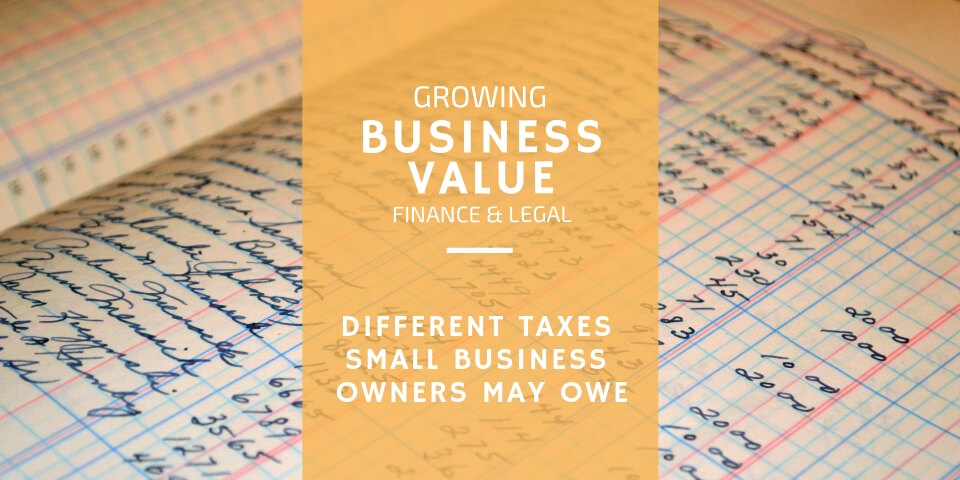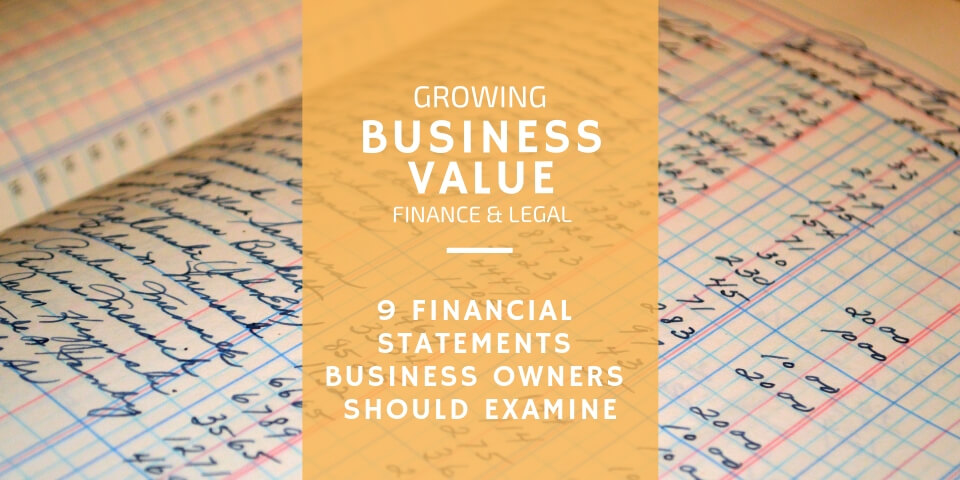
Zero-Based or Incremental… Which Budget Strategy is Best for You?
March 25, 2019
“Missing” Taxes Checklist for Small Business Owners
March 29, 20199 Financial Statements Business Owners Should Examine Regularly

I don’t know about you, but I like to look at my company’s financial reports. To me, financial statements are vital for the S.W.O.T. Analysis you and your team members perform during your strategic planning sessions. If read and understood, they can reveal many of your company’s Strengths, Weaknesses, Opportunities, and Threats. However, I often run across business owners who do not know what types of financial statements to pull or how to read them once printed. Therefore, I’ve put together a list of nine financial statements business owners should examine during their strategic planning sessions.
Podcast Time Index for “What are the best Financial Reports for Business Owners to examine?”
00:22 – What are the best Financial Reports for Business Owners to examine?
01:30 – The Balance Sheet
04:28 – The Income Statement
07:47 – The Cash Flow Statement
09:27 – The Account Receivable Report
12:29 – The AR Day vs AP Day Report
14:27 – The Budget vs Actual Report
15:33 – The Daily Average Sales Report
16:57 -The Operating Cash Flow Report
18:05 – The Net Profit Margin Over Time Report
19:37 – Summary
9 Financial Statements Business Owners Should Examine
#1. Balance Sheet
One of the most important reports for small business owners is the Balance Sheet. It lists your company’s short-term and long-term liabilities and assets. If you compare Balance Sheets year after year, you can determine whether or not your net worth is increasing or decreasing, at least your book value net worth. The Balance Sheet also reveals the health of your company and your owner’s equity percentage.
#2. Income Statement
Just as important as the Balance Sheet, though, is your company’s Income Statement – its Profit and Loss Statement. At its most basic level, it shows you whether or not your company made money or lost money monthly, quarterly, or yearly. However, if you run a year-by-year comparison, you can track revenue and expense trends.
For more information about the Income Statement, be sure to read Profit and Loss: Reading Your Company’s P&L Statement.
#3. Cash Flow Statement
Another valuable report for you to review, especially if you keep inventory, is the Cash Flow Statement. Similar to the P&L Statement, its primary concern is the company’s profitability. Typically, you run a Cash Flow Statement at the end of the month to determine the difference in your beginning and ending cash balance. Yet, it also reveals how much money is coming into the company and going out of the company in a specific period of time.
#4. Accounts Receivable Report
Sometimes called the Accounts Receivable Ageing Report, the Accounts Receivable Report reflects how much money your company has invoiced that hasn’t been paid yet. Usually, the report is broken into 4 different categories:
- 0-30 days, or current bills due
- 31-60 days, or bills over 30 days late
- 61-90 days, or bills over 60 days late
- >90 days, or bills over 90 days late
As a business owner, you want to see how much money is sitting in each of those categories. Ideally, you want 90% of your bills to be current, or within 0-30 days due. If you notice that a lot of money is sitting in your 90 days overdue account, though, you need to look for the problems happening within your AR collections department.
If you need help with the Accounts Receivable division of your company, be sure to read 19 Tips for Improving Accounts Receivable Collections.
#5 AR Day Versus AP Day Report
Another report you may want to review is the AR (Accounts Receivable) Day Versus AP (Accounts Payable) Day Report. Typically run in a service industry, this report breaks down the ratio between a day’s billables and a day’s receivables. Essentially, you can use this report to analyze whether or not your daily profit margin matches your company’s standard yearly profit margin (which you get from your Profit and Loss Statement).
#6. Budget Versus Actual Report
Assuming you’ve created your yearly budget and put it into your accounting software system, you can also run a Budget Versus Actual Report. This statement compares where your income and expenses are to where you thought they would be at any given point throughout the year. It allows you to track overspending or under-spending, and it allows you to monitor your revenue.
#7. Daily Average Sales Report
Essentially an inventory management report, the Daily Average Sales Report can track product sales for you. Typically, this report shows items that sold so that you identify which products you need to reorder. However, what the report doesn’t show can be just as important as what it does show. If certain products never show up on the sales report, then you can also determine which products not to reorder.
#8. Operating Cash Flow Report
Another report I encourage business owners to review is the Operating Cash Flow Report. This financial statement shows you the company’s financial viability, or how much money you have on hand to operate the company. You’re not building this report to see how much money you need on a month by month basis. Instead, you’re looking to see how much cash you have to weather financial, political, economic, or personal storms your business could face. Essentially, it’s a forecast of your company’s sustainability.
For more information on this topic, be sure to read How Much of a Cash Reserve Does My Business Need.
#9. Net Profit Margin Over Time
Although similar to the AR versus AP Daily Report, the Net Profit Margin Over Time report helps seasonal industries track net profit margins during specific time periods. If you can track seasonal margins, you can figure out how to cut back, how to grow, or how to increase capacity without hurting the overall annual numbers for the company.
Conclusion
Above, I’ve listed several different financial statements and reports you should analyze while you are strategically planning the value growth of your company. If you know which statements to pull and how to read them, you can identify many of your business’s strengths, weaknesses, opportunities, and threats. For more information about these reports, be sure to listen to the podcast attached to this article, or find it on Stitcher, Spotify, iTunes, or Libsyn.
Also, join me for my next article where I’ll be outlining the different taxes small business owners may have to pay.



